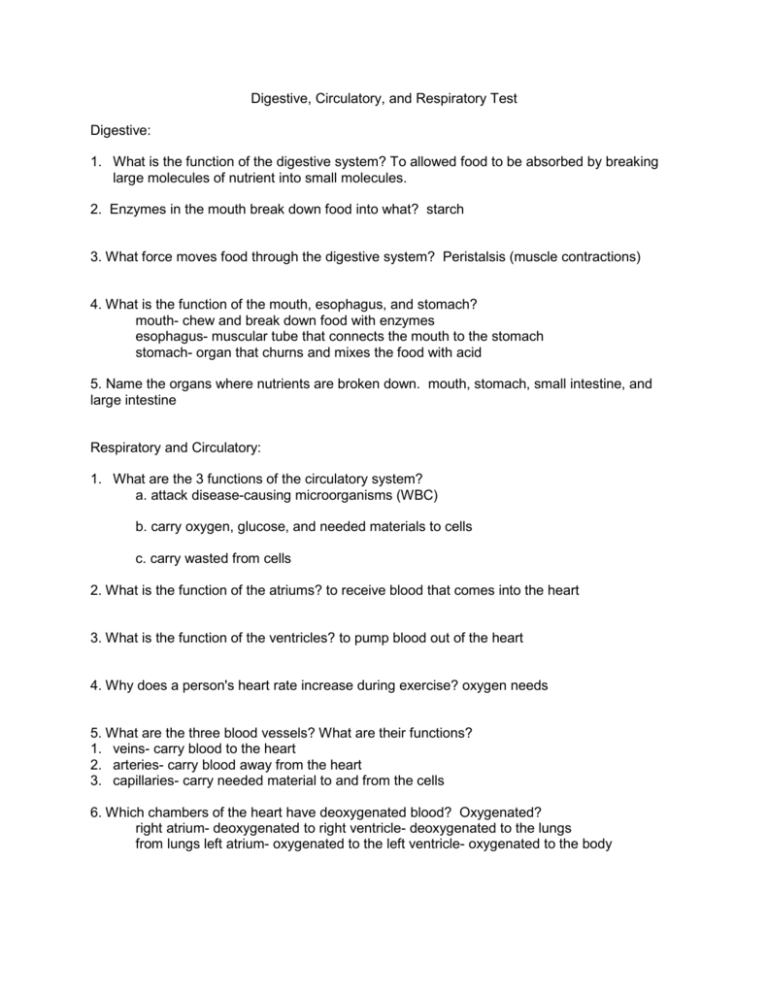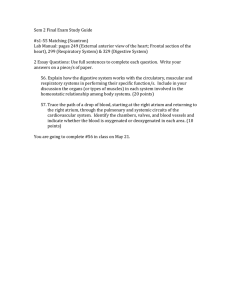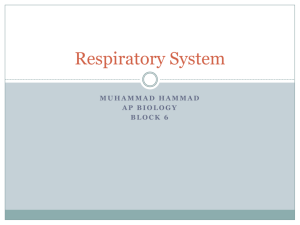Digestive, Circulatory, and Respiratory Test Digestive: What is the
advertisement

Digestive, Circulatory, and Respiratory Test Digestive: 1. What is the function of the digestive system? To allowed food to be absorbed by breaking large molecules of nutrient into small molecules. 2. Enzymes in the mouth break down food into what? starch 3. What force moves food through the digestive system? Peristalsis (muscle contractions) 4. What is the function of the mouth, esophagus, and stomach? mouth- chew and break down food with enzymes esophagus- muscular tube that connects the mouth to the stomach stomach- organ that churns and mixes the food with acid 5. Name the organs where nutrients are broken down. mouth, stomach, small intestine, and large intestine Respiratory and Circulatory: 1. What are the 3 functions of the circulatory system? a. attack disease-causing microorganisms (WBC) b. carry oxygen, glucose, and needed materials to cells c. carry wasted from cells 2. What is the function of the atriums? to receive blood that comes into the heart 3. What is the function of the ventricles? to pump blood out of the heart 4. Why does a person's heart rate increase during exercise? oxygen needs 5. What are the three blood vessels? What are their functions? 1. veins- carry blood to the heart 2. arteries- carry blood away from the heart 3. capillaries- carry needed material to and from the cells 6. Which chambers of the heart have deoxygenated blood? Oxygenated? right atrium- deoxygenated to right ventricle- deoxygenated to the lungs from lungs left atrium- oxygenated to the left ventricle- oxygenated to the body 7. How is your pulse rate related to your heart beat? if the pulse rate increases your heart beats faster and vice versa 8. Name the four components of blood and describe their functions. plasma- clear liquid of the blood platelets- helps blood to clot red blood cells - carries needed materials to the cells such as oxygen and glucose white blood cells- attacks disease-causing microorganisms 9. What is the function of the respiratory system? to bring oxygen into the body 10. What is the name of the flap of tissue that covers the trachea when you shallow food/liquid? epiglottis 11. Which structures in the respiratory system are divided into smaller and smaller tubes and resemble tree branches? bronchial tubes 12. Where specifically does blood gas exchange occur in the respiratory system? alveoli 13. What effect does pneumonia have on the lungs and respiratory system? it decreases the efficiency of the blood gas exchange because fluid is covering the lungs 14. Which type of blood vessel surrounds the alveoli? capillaries 15. How does the heart and lungs work together to provide oxygen to the cells? The lungs supply oxygen to the blood and the heart delivers the blood to the body 16. Name the structures of the respiratory system. nasal cavity, pharynx, trachea, bronchi, bronchial tubes, alveoli, lungs 17. What mineral in the blood attracts oxygen molecules and gives the blood the bright red color? iron 18. Be able to label all the chambers of the heart and the aorta when given a diagram.






